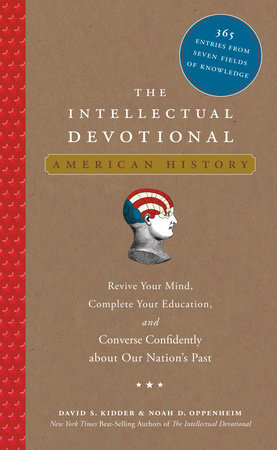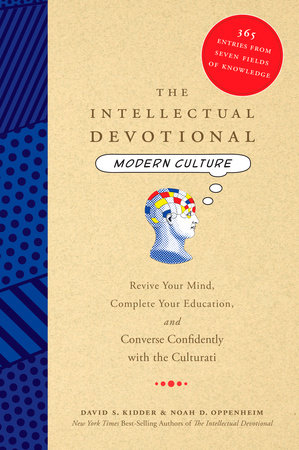Excerpt
The Intellectual Devotional: American History
Monday, Day 1 Politics & Leadership
week 1
John Smith
In the spring of 1607, a group of English settlers reached North America after almost five months at sea. Exhausted by the long voyage, they landed on a small, uninhabited island in Virginia off the coast of Chesapeake Bay. The small colony they built there--the first permanent English settlement in the New World--they named Jamestown, after King James I of England.
One of the best-known leaders of the Jamestown expedition was Captain John Smith (c. 1580-1631), a twenty-seven-year-old adventurer and soldier of fortune who had fought as a mercenary in several European wars before signing up for the English mission to Virginia. Courageous and headstrong, Smith took charge of the colony for much of the next two difficult years, before an injury from a gunpowder explosion forced him to return to England in 1609.
Conditions for the settlers at Jamestown, who were surrounded by Native Americans, were arduous. During their first winter in Virginia, many of the 108 colonists died from disease or Indian attack. A primitive wooden stockade built around the settlement did not halt the attacks. Smith himself was captured by the Indians that winter and held hostage for about a month before he was released.
For the next year, Smith tried to impose discipline on the dysfunctional colony. Many men in the group, the members of which had come to Virginia seeking riches, considered themselves English "gentlemen" and hadn't expected to labor in the New World; Smith put an end to their pretensions, famously declaring that "he who does not work, will not eat."
After Smith's departure, the colony nearly disbanded without his leadership. After a few more rocky years, and an infusion of more settlers from England, Jamestown recovered. But as more English settlers migrated to the region, other towns soon overtook Jamestown in importance, and the Virginia capital moved to Williamsburg in 1698. Jamestown virtually disappeared, and the site of the original stockade later became a farm before it was rescued by historical preservationists.
Additional Facts
1. Smith had an unfortunate habit of being taken prisoner. Prior to coming to the Americas, he had been employed as a mercenary in Europe, where he was captured in Hungary and sold as a slave to the Turkish pasha before eventually escaping.
2. In a later expedition to North America in 1614, Smith explored the coastline of the region north of Virginia, which he dubbed New England.
3. Smith claimed that Pocahontas, the young teenage daughter of the powerful Powhatan chief, saved his life by stopping her father from executing him. Pocahontas married one of the Jamestown settlers, John Rolfe, in 1614 and visited England with him in 1616.
Tuesday, Day 2 War & Peace
Pequot War
Short and bloody, the Pequot War (1636-1638) was the first major clash between Native Americans and English settlers in the New World. The Pequot were one of the most powerful tribes in the region that is now Connecticut, but they were nearly annihilated in the war. In the wake of the conflict, Native Americans in New England were pushed onto smaller and smaller settlements as their land was taken by white settlers streaming to the New World from Europe.
The first permanent European settlements in Connecticut were founded by the Puritans in 1633. Tensions with the Pequots flared almost immediately. The immediate cause of the war was the massacre of an English ship's crew in 1636, which the Puritans blamed on Pequot warriors. The English launched retaliatory raids and quickly convinced many other Indian tribes in the area to join the war. With their native allies and superior weaponry, the English easily defeated the Pequots. By modern standards, the English war was nearly genocidal. The English soldiers regarded all Native Americans as heathens and a threat to peace in the New England wilderness, and the soldiers indiscriminately killed hundreds of Pequot women and children as well as warriors.
With most of the Pequot leadership wiped out, the Treaty of Hartford in 1638 put a halt to the brutal war. The English, determined to erase even the name of the Pequots, officially abolished the tribe, enslaving some members and distributing the rest as spoils to their Native American allies. Major conflict between Native Americans and the English would resurface, however, during King Philip's War in 1675.
Additional Facts
1. The name Connecticut came from the Mohegan word Quinnehtukqut, meaning long tidal river.
2. The English outlawed the use of the word Pequot after the war, but it entered New England lore anyway and later served as the inspiration for the name of the ship Pequod in Herman Melville's masterpiece, Moby-Dick.
3. Descendants of the Pequots, confined to a tiny reservation in Connecticut, eventually opened the world's largest casino, Foxwoods, in 1993.
Wednesday, Day 3 Rights & Reform
Slavery
Beginning in 1619, when the first group of twenty Africans arrived at Jamestown in chains, thousands of slaves were imported into the British colonies of North America. Within a few generations, slave labor formed the basis of the South's agricultural economy and had spread north to the rest of the original thirteen colonies. By any standard, slavery was an unspeakable human tragedy that caused immeasurable harm to its victims.
Although slavery was part of the economy in both the North and the South, the institution eventually took on distinct guises in the two regions. To describe the differences, historians distinguish between a "slave society" and a "society with slaves." A "slave society" was one in which slavery dominated the major forms of economic production, which was the case in the South by the eighteenth century.
A "society with slaves," in contrast, refers to a society in which slaves did not dominate the economic modes of production and instead provided supplemental labor, such as work conducted within the home. In Massachusetts in the mid-1700s, for instance, only about one in eight households owned a slave, and the typical slaveholder had only two slaves. Rather than toil in the fields, Northern slaves often worked as maids, blacksmiths, coopers, carpenters, and house servants.
Because of the differing roles slavery played in the societies of the North and the South, the extent to which the two regions relied on slavery began to diverge in the eighteenth century. In the South, slavery became more important, while in the North, the institution began to fade. At the time of the American Constitutional Convention of 1787, many of the Founders assumed that slavery would eventually die out. Indeed, after the convention, various states in the North began the process of abolishing slavery, granting slaves their freedom in a given year or at a certain age, depending on the law their state established.
However, just as slavery was ending in the North, the invention of the cotton gin in 1793 guaranteed that the institution would remain integral to the Southern economy--laying the groundwork for widening regional differences in the nineteenth century.
Additional Facts
1. The 1840 census listed one slave in New Hampshire.
2. Slavery was also common throughout Europe's other New World colonies. In the French colony of Haiti, Toussaint-Louverture (1743-1803) led a successful slave revolt in 1793.
3. The first twenty African slaves taken to Jamestown aboard a Dutch warship were from the modern-day nations of Congo and Angola.
Thursday, Day 4 Business
Tobacco
In 1492, sailors aboard Christopher Columbus's first expedition to the New World were puzzled by the sight of Native Americans in the Caribbean smoking rolled-up tobacco leaves. Several of the crew members took the odd custom back to Europe with them, where it caught on immediately. Within a generation, smoking was the rage in the Old World; the resulting demand for the tobacco leaf helped fuel the subsequent colonization of the Americas.
The importance in American history of the tobacco plant, Nicotiana tabacum, can hardly be exaggerated. Tobacco was the driving force behind many European ventures in the New World, the single biggest cash crop of the first English settlements in North America, and the backbone of the economy in Virginia, the largest of the thirteen colonies.
In Virginia, large-scale tobacco growing began almost immediately after the establishment of the Jamestown colony. Indeed, in 1620--the year the Pilgrims arrived at Plymouth--the Virginia colony was already exporting 119,000 £ds of tobacco back to England. In Virginia, thousands of English settlers established tobacco farms clustered in the Tidewater region near the present-day city of Norfolk. By the end of the seventeenth century, Europe was importing more than 25 million £ds of tobacco.
Many of the workers on tobacco farms were slaves. However, because of the way tobacco was farmed and cured, the crop was not typically associated with large-scale plantations. After the invention of the cotton gin in 1793, cotton surpassed tobacco as the biggest cash crop in the South. Although no longer the country's agricultural mainstay, tobacco remains a significant part of the American economy today, despite the major health risks associated with smoking.
Additional Facts
1. A definitive link between smoking and cancer was not proven until the twentieth century, but the intuitive danger of inhaling smoke was grasped much earlier; King James I (1566-1625), the namesake of the Jamestown colony, hated smoking and published a notorious pamphlet attacking the "filthie noveltie."
2. Nicotine, the addictive element in tobacco, is so toxic it is also used as an insecticide.
3. Jamestown's first major tobacco farmer was John Rolfe (1585-1622), the husband of the legendary Native American princess Pocahontas (c. 1595- 1617).
Friday, Day 5 Building America
Pueblo Civilization
Some of the oldest known structures in North America, the stone houses and ceremonial sites of the ancient Pueblo civilization were built around 850 AD in the parched canyons of the present-day southwestern United States. Archeologists believe that the cliffside complexes, each a stupendous feat of prehistoric engineering, were in use for about 400 years before they were abruptly abandoned. The ancient cliff dwellers who lived in them were the ancestors of modern-day Native American tribes including the Pueblo, Hopi, and Zuni.
The ancient Pueblo civilization existed for about 2,000 years in the Four Corners region where modern-day Arizona, New Mexico, Colorado, and Utah meet. Sometimes known as the Anasazi, the tribes began carving their famous sandstone structures into canyon walls during a period of explosive population growth beginning about 700 AD. Historians believe the buildings were used for housing, storage, and religious rites.
Set amid the arid mesas and canyons of the Southwest, the empty cliff dwellings dazzled the white settlers who first encountered them in the nineteenth century. Archeologists have spent decades debating whether drought, civil war, religious turmoil, or a combination of factors caused the Pueblo to abandon their elaborate complexes around 1250 AD. Whatever the cause, the ancient Puebloans eventually resettled near present-day Albuquerque and Santa Fe, New Mexico.
Today, thousands of abandoned Pueblo sites are scattered throughout the Four Corners region of the Southwest. The best known are found at Mesa Verde National Park in Colorado and Chaco Canyon in northwestern New Mexico.
Additional Facts
1. The sandstone formations in the Pueblo region are believed to be about 250 million years old.
2. Anasazi, meaning ancestral enemy in Navajo, though not considered a politically correct term, remains in widespread use.
3. Archaeologists exploring ancient Pueblo sites have unearthed many discarded tools, including wooden flutes almost 1,500 years old.
Saturday, Day 6 Literature
Anne Bradstreet
Anne Bradstreet (c. 1612-1672) authored the first book of poetry published in the British colonies of North America. The wife of a leading Puritan official, Simon Bradstreet, she arrived in Massachusetts in 1630, aboard the first ship carrying Puritans to the New World. Although she began writing early in life, Bradstreet's poetry was not published until 1650, when her book The Tenth Muse Lately Sprung Up in America appeared in print.
The subjects of Bradstreet's poems reflected the difficult lives of the early English settlers, as well as the distinct challenges faced by women in seventeenth-century America. Bradstreet wrote about common problems for the Puritans like sickness and house fires, in addition to more metaphysical poems about her own religious beliefs. The Bradstreets had eight children, and many of Anne's later poems addressed the travails of raising a family amid the difficult conditions of the New World.
Bradstreet's poems, influenced by such English poets as Philip Sidney (1554- 1586) and Edmund Spenser (c. 1552-1599), show mastery of formal technique and wide-ranging erudition about subjects ranging from medicine to arcane Puritan theology. Many of her poems are also tender. One of her most well- known verses, "To My Dear and Loving Husband," which was not published until after her death, is a poignant love letter to her husband:
If ever two were one, then surely we.
If ever man were lov'd by wife, then thee.
If ever wife was happy in a man,
Compare with me, ye women, if you can.
I prize thy love more than whole Mines of gold
Or all the riches that the East doth hold.
My love is such that Rivers cannot quench,
Nor ought but love from thee give recompense.
Published women poets were a rarity in the seventeenth century, and Bradstreet's poems occasionally hint at some of her fellow Puritans' hostility toward her literary endeavors. For example, in one poem she wrote: "I am obnoxious to each carping tongue / Who says my hand a needle better fits." Many of Bradstreet's most well-known poems were not published until after her death, but she is now considered America's first English- language poet.
Additional Facts
1. Bradstreet's father, Thomas Dudley (1576-1653), also immigrated to Massachusetts and became a leading political opponent of John Winthrop (1588-1649). The two men alternated in the governorship for much of the first two decades of the colony's existence.
2. One of the original Boston Brahmin families, descendents of the Bradstreets include the poet Oliver Wendell Holmes (1809-1894).
3. Bradstreet's husband became governor of Massachusetts after her death.
Sunday, Day 7 Arts
John Singleton Copley
The leading painter of colonial-era America, John Singleton Copley (1738- 1815) won acclaim for his big, detailed portraits of many of the most prominent citizens in his native Boston, including Revolutionary War leaders Samuel Adams (1722-1803) and Paul Revere (1734-1818). Although Copley himself left Boston in 1774, never to return, he continued painting in London and won election to Britain's prestigious Royal Academy of Art, a rare honor for an American-born painter.
Copley was born in Boston to a poor Irish immigrant family, and his father died when he was a young boy. At the time, the thirteen colonies lacked the great art schools of Europe, and Copley largely taught himself to paint.








